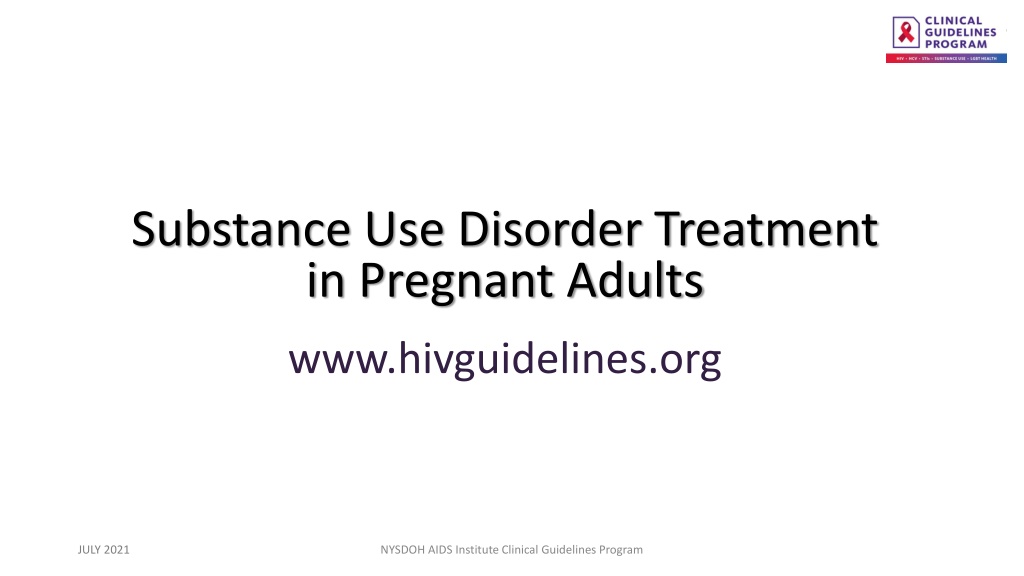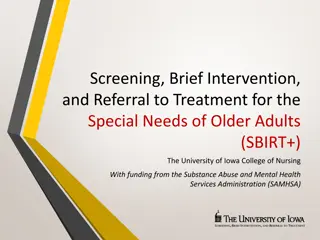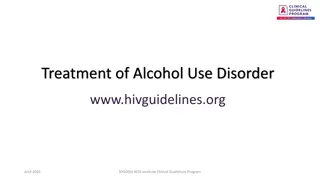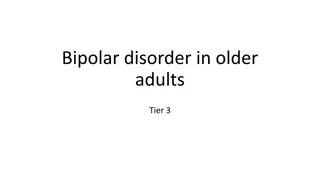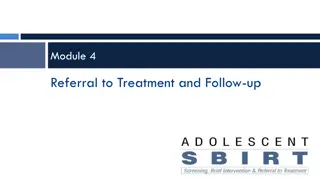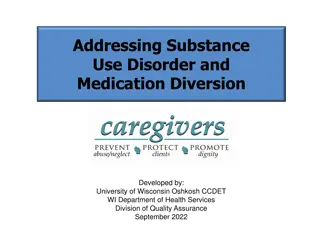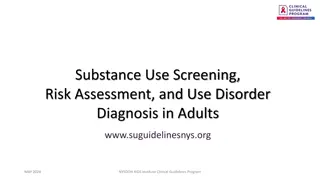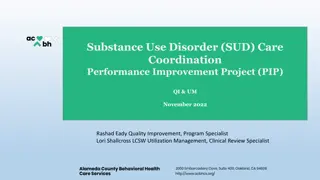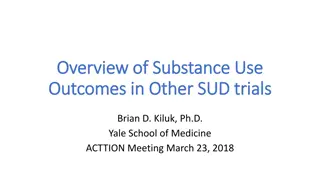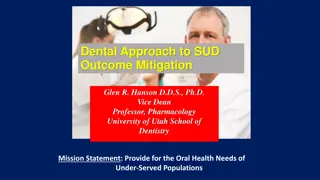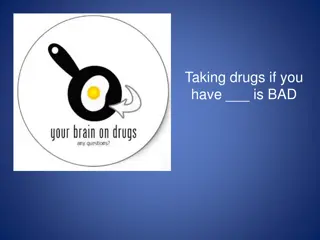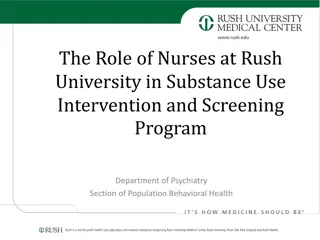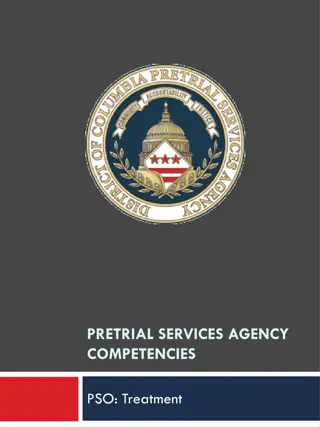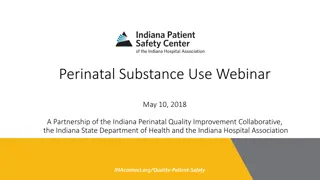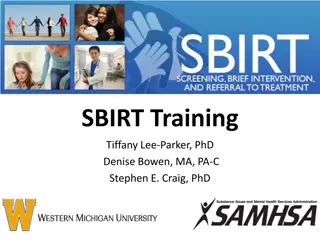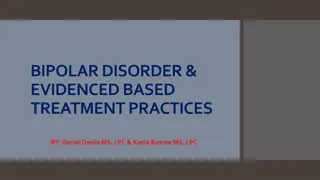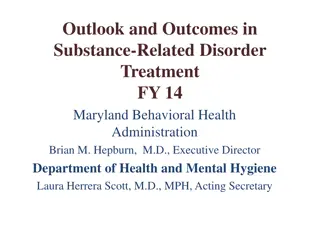Substance Use Disorder Treatment in Pregnant Adults: Guidelines and Recommendations
This guideline provides evidence-based recommendations for the management of substance use disorder (SUD) during pregnancy, aiming to expand access to treatment, promote harm reduction strategies, address stigma, and improve maternal and neonatal health outcomes. It highlights the prevalence of SUDs during pregnancy, the importance of healthcare provider awareness, and treatment goals including abstinence, preventing adverse effects, staying in care, reducing high-risk behaviors, and enhancing overall quality of life.
Download Presentation

Please find below an Image/Link to download the presentation.
The content on the website is provided AS IS for your information and personal use only. It may not be sold, licensed, or shared on other websites without obtaining consent from the author. Download presentation by click this link. If you encounter any issues during the download, it is possible that the publisher has removed the file from their server.
E N D
Presentation Transcript
Substance Use Disorder Treatment in Pregnant Adults www.hivguidelines.org JULY 2021 NYSDOH AIDS Institute Clinical Guidelines Program
Purpose of This Guideline Purpose of This Guideline Inform clinicians of available treatment options for SUDs to expand access to SUD treatment for pregnant individuals. Provide evidence-based recommendations to guide the management of substance use and SUDs during pregnancy. Promote a harm reduction approach to SUD treatment in pregnancy by providing practical strategies for reducing the negative consequences of drug and alcohol use during pregnancy. Increase awareness among healthcare providers about the stigma associated with drug and alcohol use during pregnancy. JULY 2021 NYSDOH AIDS Institute Clinical Guidelines Program www.hivguidelines.org
Key Points Key Points Healthcare providers who have a conscious or unconscious bias against pregnant patients who use drugs or alcohol may be reluctant to provide care or may make erroneous judgments about a patient s fitness as a parent. Discrimination and prejudice impede engagement in care, including prenatal care, and can impair parental and neonatal health outcomes. JULY 2021 NYSDOH AIDS Institute Clinical Guidelines Program www.hivguidelines.org
Prevalence of Substance Use Disorder Prevalence of Substance Use Disorder During Pregnancy During Pregnancy In 2018, approximately 4.7% of pregnant individuals reported cannabis use, 9.9% reported alcohol use, 0.9% reported opioid use, and 11.6% reported tobacco use in the last 30 days. Alcohol: In 2018, 19.6% of respondents in their first trimester and 4.7% in their second or third trimesters reported alcohol use in the last 30 days. Overall, 38.2% of pregnant respondents who reported alcohol use in the previous 30 days also reported using 1 or more other substances in the same period, most commonly tobacco and cannabis. Tobacco: The overall prevalence of tobacco use during pregnancy in the United States continues to decline, but less significant declines have been reported among people of lower education levels and socioeconomic status. Cannabis: The estimated prevalence of cannabis use in the last 30 days increased from 3.4% in 2002 to 2003 to 4.7% in 2018; over the same period, the prevalence of daily or near-daily cannabis use in the last 30 days increased from 0.9% to 1.5%. JULY 2021 NYSDOH AIDS Institute Clinical Guidelines Program www.hivguidelines.org
Substance Use Disorder Treatment Goals Substance Use Disorder Treatment Goals During Pregnancy During Pregnancy Abstaining from or reducing substance use Preventing adverse effects of substance use or withdrawal for the pregnant individual and fetus Staying in care, which can also facilitate prevention, diagnosis, and treatment of other conditions Reducing high-risk behaviors, such as injection drug use and use or reuse of unsterile equipment and sharing injection equipment, and reducing related complications, such as infection and overdose Improving the quality of life and other social conditions, such as employment, stable housing, and risk of incarceration JULY 2021 NYSDOH AIDS Institute Clinical Guidelines Program www.hivguidelines.org
Recommendations: Recommendations: Opioid Use Disorder Treatment Opioid Use Disorder Treatment Clinicians should advise their patients to avoid abrupt discontinuation of opioids, including BUP or methadone, during pregnancy because of the risks posed by withdrawal or resumption of unhealthy use (i.e., heroin) following abstinence. (B2) When offering pregnant patients BUP treatment or referral to an OTP for methadone treatment, clinicians should discuss the maternal and fetal risks and benefits of both medications (see Considerations in Choosing Methadone or Buprenorphine for OUD Treatment During Pregnancy); the treatment choice should be based on patient preference whenever possible. (A3) Clinicians should educate patients who take opioids, BUP, or methadone during pregnancy about the risk of NOWS, an expected and treatable outcome. (A3) Clinicians should inform patients that breastfeeding while taking BUP or methadone is safe and may reduce the risk of NOWS. (A2) Clinicians should not recommend naltrexone initiation, which requires withdrawal from opioids, for a pregnant patient who is actively using opioids. (A2) If a pregnant patient is abstinent from opioids and requests treatment with naltrexone, clinicians should discuss naltrexone as an alternative treatment and inform the patient of the associated risks and benefits. (A3) Clinicians should inform patients who become pregnant while taking naltrexone of the risks and benefits and preferred pharmacologic treatment options (see Benefits and Risks of Continuing or Stopping Naltrexone During Pregnancy). (B3) JULY 2021 NYSDOH AIDS Institute Clinical Guidelines Program www.hivguidelines.org
Recommendations: Recommendations: Opioid Use Disorder Treatment, Opioid Use Disorder Treatment, continued continued Before initiating BUP in a pregnant patient with OUD, clinicians should confirm that the patient is experiencing at least mild opioid withdrawal symptoms (B3) and should consult with an experienced substance use treatment provider regarding the risk of precipitated withdrawal. (A3) Clinicians should advise patients who initiate BUP or methadone during pregnancy, and those who become pregnant while taking BUP or methadone, to continue treatment throughout pregnancy, labor, delivery, postpartum, and breastfeeding. (A2) At each visit, clinicians should monitor pregnant patients taking BUP for opioid cravings and withdrawal symptoms and, if present, increase the dose as appropriate for the individual and reassess at the next visit; any dose increase should be maintained until treatment goals can be evaluated postpartum. (A3) If taking a dose of 32 mg BUP mg daily does not allow the patient to meet treatment goals, clinicians should recommend methadone treatment. (A3) If a pregnant patient is considering a change from methadone to BUP, the clinician should consult an experienced substance use treatment provider because of the risk of precipitated withdrawal. (A3) JULY 2021 NYSDOH AIDS Institute Clinical Guidelines Program www.hivguidelines.org
Considerations in Choosing Methadone or Considerations in Choosing Methadone or Buprenorphine for OUD Treatment During Pregnancy Buprenorphine for OUD Treatment During Pregnancy Factor Buprenorphine Available through office-based prescription or a specialty opioid treatment program Mild opioid withdrawal required before treatment can be initiated Cautious, slow, and low-dose induction advised Safe throughout pregnancy, labor, delivery, and postpartum Dose can be increased to control cravings and prevent withdrawal Dose increase may be required later in pregnancy to maintain the appropriate effect Methadone Available only through a specialty opioid treatment program Pregnant individuals receive priority access Setting Initiation requirement Withdrawal not required Safety and effectiveness Treatment duration Continue treatment throughout pregnancy, labor, delivery, and postpartum Can the regimen be changed? Switch to methadone is possible if needed to control cravings and avoid opioid withdrawal Switch to BUP is not advised because of the potential for precipitated opioid withdrawal symptoms JULY 2021 NYSDOH AIDS Institute Clinical Guidelines Program www.hivguidelines.org
Considerations in Choosing Methadone or Considerations in Choosing Methadone or Buprenorphine for OUD Treatment During Buprenorphine for OUD Treatment During Pregnancy, Pregnancy, continued continued Factor Buprenorphine Methadone Effect on opioid use Equally effective in reducing opioid use during pregnancy Duration, severity, and dose of medication required for neonatal opioid withdrawal syndrome may be reduced No known effects on growth or cognitive or psychological development Effect on infant No known effects on growth or cognitive or psychological development Pain management Nonopioid and opioid analgesic agents are used in addition to the maintenance OUD treatment dose of methadone or BUP. The addition of a short-acting full-agonist opioid can be considered for managing moderate to severe acute pain. When adding a full- agonist opioid analgesic, patients will likely need a higher dose than opioid-naive patients to achieve adequate analgesia. Breastfeeding Breastfeeding, breastmilk, and skin-to-skin contact all reduce the severity and duration of neonatal opioid withdrawal syndrome JULY 2021 NYSDOH AIDS Institute Clinical Guidelines Program www.hivguidelines.org
Benefits and Risks of Continuing or Benefits and Risks of Continuing or Discontinuing Naltrexone During Pregnancy Discontinuing Naltrexone During Pregnancy Continuing Naltrexone Discontinuing Naltrexone Benefits: Ongoing blockade of the mu-opioid receptor decreases opioid cravings; no risk of neonatal opioid withdrawal syndrome (NOWS) in the neonate Benefit: No fetal in utero exposure Risks: Insufficient data regarding teratogenicity or effects on milk production or infants exposed through breastfeeding Risks: Reduced opioid tolerance that could result in overdose if opioid use is resumed, risk of NOWS increased if the patient uses opioids JULY 2021 NYSDOH AIDS Institute Clinical Guidelines Program www.hivguidelines.org
Key Points: Key Points: Opioid Use Disorder Treatment During Pregnancy Opioid Use Disorder Treatment During Pregnancy Opioid overdose during pregnancy is an increasing cause of and contributor to maternal mortality. Naloxone is the standard of care for overdose prevention in pregnant Individuals. JULY 2021 NYSDOH AIDS Institute Clinical Guidelines Program www.hivguidelines.org
Recommendations: Recommendations: Neonatal Opioid Withdrawal Syndrome (NOWS) Neonatal Opioid Withdrawal Syndrome (NOWS) Clinicians should provide patient education about NOWS that addresses the risk of NOWS, harm reduction strategies, typical symptoms and duration, and pharmacologic and nonpharmacologic treatment options. (A3) When an infant is at risk of NOWS, the clinician should recommend postpartum contact, including breastfeeding, rooming-in, and skin-to- skin contact. (A2) JULY 2021 NYSDOH AIDS Institute Clinical Guidelines Program www.hivguidelines.org
Recommendations: Recommendations: Alcohol Use Disorder Treatment Alcohol Use Disorder Treatment Clinicians should recommend inpatient alcohol withdrawal management for pregnant patients with or at risk for moderate, severe, or complicated alcohol withdrawal (CIWA-Ar scores 10), and consult with an OB/GYN. (A3) Clinicians should use caution when prescribing a benzodiazepine medication for pregnant patients. (B3) Clinicians should advise pregnant patients who use alcohol to abstain from or minimize use during pregnancy and minimize use during breastfeeding to prevent harm to the developing fetus or infant. (A2) Clinicians should provide harm reduction counseling to help minimize the effects of alcohol on the patient and the fetus. (A3) If a pregnant individual cannot decrease or cease alcohol use, the clinician should discuss pharmacotherapy for AUD as a harm reduction approach and engage the patient in shared decision-making regarding its use. (B3) If a patient becomes pregnant while taking pharmacologic medication for AUD or requests medication during pregnancy, clinicians should inform them of the risks and benefits of preferred agents during pregnancy and breastfeeding. (A3) Clinicians should identify and inform patients with AUD and risky alcohol use about available support or behavioral treatment options and provide these options or refer as indicated. (A3) JULY 2021 NYSDOH AIDS Institute Clinical Guidelines Program www.hivguidelines.org
Recommendation: Recommendation: Tobacco Use Disorder Treatment Tobacco Use Disorder Treatment For pregnant patients with tobacco use disorder, clinicians should: Advise patients to abstain from or minimize use during pregnancy to prevent harm to themselves and the fetus. (A2) Offer nicotine replacement therapy with or without bupropion after discussing the risks and benefits. (A2) Perform or refer for psychosocial counseling and support. (A1) JULY 2021 NYSDOH AIDS Institute Clinical Guidelines Program www.hivguidelines.org
Recommendations: Recommendations: Treatment of Other Substance Use Disorders Treatment of Other Substance Use Disorders Clinicians should advise pregnant patients who use any substances to abstain from or minimize use during pregnancy to prevent adverse maternal and neonatal effects. (A3) Clinicians should identify and inform patients about all available treatment options and resources for support and provide appropriate interventions or referrals as needed. (A3) JULY 2021 NYSDOH AIDS Institute Clinical Guidelines Program www.hivguidelines.org
Need Help? Need Help? NYSDOH AIDS Institute Clinical Guidelines Program www.hivguidelines.org
Access the Guideline Access the Guideline www.hivguidelines.org > Substance Use Disorder Treatment in Pregnant Adults Also available: Printable pocket guide and PDF NYSDOH AIDS Institute Clinical Guidelines Program www.hivguidelines.org
